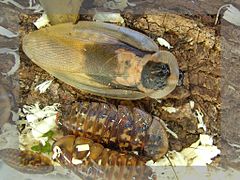Exopterygota
| Exopterygota Temporal range: Carboniferous–Recent |
|
|---|---|
 |
|
|
Death's head cockroach or brown-winged Blaberus hybrid Adult (above) and two immatures (note wing stubs) |
|
| Scientific classification | |
| Kingdom: | Animalia |
| Phylum: | Arthropoda |
| Class: | Insecta |
| Subclass: | Pterygota |
| Infraclass: | Neoptera |
| Superorder: | Exopterygota |
| Orders | |
|
Notoptera (ice-crawlers and gladiators) |
|
Notoptera (ice-crawlers and gladiators)
Plecoptera (stoneflies)
Embioptera (webspinners)
Zoraptera (angel insects)
Dermaptera (earwigs)
Orthoptera (grasshoppers, etc)
Phasmatodea (stick insects)
Blattodea (cockroaches and termites)
Mantodea (mantids)
Psocoptera (booklice, barklice)
Thysanoptera (thrips)
Phthiraptera (lice)
Hemiptera (true bugs)
For Extinct groups and possible future splits, see text.
The Exopterygota, also known as Hemipterodea, are a superorder of insects of the subclass Pterygota in the infraclass Neoptera, in which the young resemble adults but have externally developing wings. They undergo a modest change between immature and adult, without going through a pupal stage. The nymphs develop gradually into adults through a process of moulting.
The Exopterygota are a highly diverse insect superorder, with at least 130,000 living species divided between 15 orders. They include termites, locusts, thrips, lice and stick insects, among many other types of insects.
...
Wikipedia
